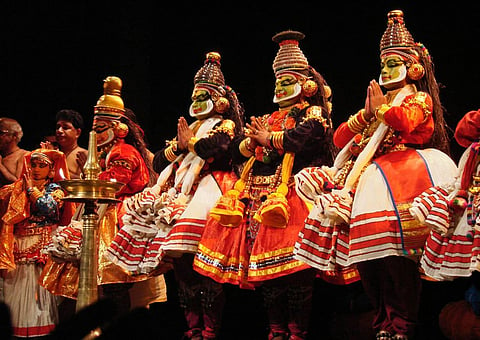
- Home
- NG Hindi
- India
- World
- Politics
- Sex & Relationships
- Entertainment
- Culture
- Lifestyle
- Economy
- Sports
- Sp. Coverage
- Misc.
- NewsGram Exclusive
- Jobs / Internships

By Meghna Nair
The curtain lifts and artists begin swaying to the beats of percussion instruments like chengila, ilattalam,shuddha maddalam, toppi maddalam, and itakka. The resonating voice of the singers create a wonderful ambience and the life of Krishna begins to unfold in the resplendent glory of Krishnanattam.
A precursor of Kathakali, Krishnanattam is an ancient dance form originated in Kerala and is known for its dynamic costumes, makeup, and beautiful headgear worn by the artists.
The make-up costumes and ornaments used in Krishnanattam are almost similar to that seen in Kathakali, though, unlike Kathakali, in Krishnanattam some characters use painted masks made of wood. Like in Theyyam (another ancient dance form), the faces of the artists are painted with vibrant colours and intricate designs.
"The beauty of Krishnanattam lies in its rhythmic movements and the dance steps. It is quite different from Kathakali. In Kathakali, there is a lot more of emphasis on the bhaavas (expressions), but here, the steps are more concentrated upon, and the language, being Sanksrit, it is tougher," explains Navami Namboothiri, a student of Kathakali in Delhi.
Krishnanattam is mainly based on Krishnagiti, a text of slokas and padams in Sanskrit. This text was composed by Manaveda, who was a Zamorin or Samoothiri (the hereditary title used by Hindu Nair rulers of Calicut). Krishnagiti contains eight cantos of slokas and padams, each of which trace the journey of Lord Krishna's life.
Krishna's story, as described in detail in the 10th and 11th cantos of Srimad Bhagavatha, Mahabharata, and Harivamsa, is presented as a dance-drama in a cycle of eight plays on eight consecutive nights, barring Tuesdays.
Each performance depicts the narratives of each canto of the Krishnagiti. The eight performances are –Avataram, Kaliyamardhanam, Raasakreeda, Kamsavadham, Swayamvaram, Banayuddham, Vividha vadham, and Swargarohanam.
Krishnanattam is a product of the Vaishnava Bhakti movement of 17th century and the dance form also was first choreographed by the Zamorin Manaveda of Calicut.
This dance-drama troupe was patronized by the Zamorins till 1958.
PKS Raja (1913-2013), a later titular Zamorin ruler of Calicut, explained, "Originally, the performance of Krishnattam was strictly restricted to the Guruvayur Temple, palaces of the members of the Zamorin's family, temples, and houses of Namboodiri Brahmins within the jurisdiction of the Zamorin's empire. Performances outside the jurisdiction of Zamorin were strictly prohibited."
Presently, the troupe has 54 artistes and is maintained by the Guruvayur Dewaswom board. If one has to book a performance, they have to get the appointment through the Devaswom board as there is no other troupe for Krishnanattam anywhere else.
The recruitment of the artists as young Hindu boys of five years is done by placing advertisements in the newspapers. The boys who can act are selected and are intensively trained.
The members of the troupe are classified into Aasan (the instructor), first grade artistes, second grade artistes and third grade artistes. The retirement age is 60.
Krishnanattam is considered to be an offering of the faithful to the deity. The devotees sponsor each performance to fulfil the desires associated with them.
It is believed that Krishnanattam is inspired by various dance forms that were prevalent in the medieval period. Thus, the critics always complain about the lack of perfection of the dance steps owing to the large number of influences.
Though the dance form is not as popular as Kathakali, it is still extensively performed, despite the inability of the audience to understand the Sanskrit songs, it is popular as an offering to please the Gods.
